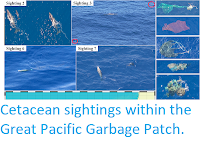Male humpback Whales, Megaptera novaeangliae, perform complex songs, both to attract potential mates and to communicate with other males within the group. These songs constantly evolve as the Whales improvise, but common themes are retained by the males within a group, so that each group of males has a distinctive song, which can be used to identify them. However, occasionally a Whale will come up with a particular variant on a song, which will not just be adopted by other members of the group, but by Whales from other groups, often across a very wide area. How this occurs is unclear, as the song can only be heard over a range of a few tens of kilometres, and it is performed in the mating season, when the males will return to the area where their mothers birthed them each winter, and each of these mating and birthing grounds is geographically distinct. One theory that has been put forward is that males also sing out of season, when they are migrating across the wider ocean, and may encounter males from other groups.
In a paper published in the journal Royal Society Open Science on 4 September 2019, a team of scientists led by Claire Owen of the Sea Mammal Research Unit at the University of St Andrews present the results of a study of the songs of male Humpback Whales around the Kermedoc Islands, which they visit each spring on their way from their winter breeding grounds to their summer feeding areas around Antarctica.
The Humpback Whales of the western South Pacific can be divided into three distinct populations, one found around the northeast coast of Australia (the Australian Population), one found around New Caledonia, Tonga and American Samoa (the Western South Pacific Population), and one found around the Cook Islands and French Polynesia (the Central South Pacific Population). New songs will typically take around two years to cross the entire region, so that each population will typically be singing a different song at any given time.
Previous studies of Humpback Whales passing through the Kermedoc Islands on the way to their summer feeding grounds, using both photo-identification and generic marker techniques, have identified Whales from multiple wintering grounds, with Whales staying in the area for an average of 4.6 days.
Owen et al. theorised that if Whales from different populations are passing through the Kermedoc Islands at the same time, then the area could potentially serve as a site where new songs are passed from one group to another. To this end Whale song was recorded in the Kermedoc Islands and each of the winter breeding grounds in the southern winter and spring of 2015 order to make a comparison.
Three distinct song types were found at the winter breeding grounds, Song 1, found in the Central South Pacific Population around the Cook Islands and French Polynesia, Song 2 found in the Western South Pacific Population around New Caledonia, Tonga and American Samoa, and Song 3 found in the Australian Population around the northeast coast of Australia. Both Song 1 and Song 2 were recorded in the Kermedoc Islands, as well as one Whale that appeared to be singing a hybrid of the two, strongly supporting the idea that songs are transmitted from group-to-group in this area, and probably other areas visited during the annual migration
See also...
The Humpback Whales of the western South Pacific can be divided into three distinct populations, one found around the northeast coast of Australia (the Australian Population), one found around New Caledonia, Tonga and American Samoa (the Western South Pacific Population), and one found around the Cook Islands and French Polynesia (the Central South Pacific Population). New songs will typically take around two years to cross the entire region, so that each population will typically be singing a different song at any given time.
Previous studies of Humpback Whales passing through the Kermedoc Islands on the way to their summer feeding grounds, using both photo-identification and generic marker techniques, have identified Whales from multiple wintering grounds, with Whales staying in the area for an average of 4.6 days.
Owen et al. theorised that if Whales from different populations are passing through the Kermedoc Islands at the same time, then the area could potentially serve as a site where new songs are passed from one group to another. To this end Whale song was recorded in the Kermedoc Islands and each of the winter breeding grounds in the southern winter and spring of 2015 order to make a comparison.
Three distinct song types were found at the winter breeding grounds, Song 1, found in the Central South Pacific Population around the Cook Islands and French Polynesia, Song 2 found in the Western South Pacific Population around New Caledonia, Tonga and American Samoa, and Song 3 found in the Australian Population around the northeast coast of Australia. Both Song 1 and Song 2 were recorded in the Kermedoc Islands, as well as one Whale that appeared to be singing a hybrid of the two, strongly supporting the idea that songs are transmitted from group-to-group in this area, and probably other areas visited during the annual migration
See also...
Follow Sciency Thoughts on
Facebook.







